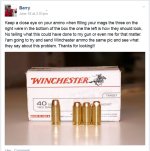First of all, I'm glad the OP is reporting that he's not seriously injured.
It's not at all surprising that someone might not be able to recall some details (or their sequence in relation to each other) when confronted by an unexpected incident, especially when it's an unusual incident for which they've never been prepared. Eye witnesses can make for some occasional contradictory testimony even under the best of conditions.

Let's give the OP a break.
Having seen some failures of plastic-framed pistols, and having learned of others in various armorer classes, from other instructors, etc over the years ... it's certainly not surprising that someone might fail to recognize when a frame has experienced a crack caused by an "over-pressure event".
The event might involve a case failure (case head blowout) or an obstructed bore. No way to know without examining the fired case and barrel, and the case was unable to be identified. However, I've also heard of at least one barrel failure (different brand of gun) reported where an obstructed bore was eliminated as the likely cause because an instructor was carefully observing and counting every hole appearing when helping a shooter. Sometimes things happen.
Anyway, I remember being told (in an armorer recert) of an instance where a LE shooter was shooting a plastic-framed gun and didn't realize that he'd experienced a short-loaded round which had left a bullet in the bore. It was later determined that at one round, and maybe 2 more rounds, were fired before the obstructed bore was cleared by the successive round(s) pushing the stuck round out of the barrel.

The barrel wasn't damaged to the point where it prevented the slide & barrel from operating normally, but the over-pressure of the gasses building up in the barrel (while the bore was obstructed) were enough to cause damage - a crack - in the frame on one side.
This crack subsequently flexed open and "pinched" the shooter's hand each time the gun was successively fired, which is the reason the problem (crack) was finally noticed. The gun kept pinching the shooter's hand each time he fired it.

I'm told the frame had to be flexed in order for the crack to become visible.
Then again, I've seen some frames damaged to the point that that large chunks of the frame material were blown away. One gun seemed operable with the missing pieces, while another one appeared obviously inoperable due to the damage.
Now, would a shooter notice if a short-loaded round came up under the striker/firing pin? Maybe. Depends.
I once had a short-loaded round occur which had enough power for the bullet to clear the bore ... and enough power for the case to be extracted & ejected (where it
barely dribbled up out of the ejection port, to bounce and roll forward off the end of the slide ... but the slide didn't travel enough to pick up and strip another round from the magazine. I was shooting another make/model of small .40, and I remember my trigger finger
freezing when the unexpected recoil impulse and dancing empty case occurred. (Part of my mind was sort of awaiting a BIG BOOM, as I recall.

)
Another guy was coincidentally shooting another make/model of small .40 when he experienced a classic case head failure, with the case web blowing at the 6 o'clock position. It stung his hand, shocked him and another instructor quite a bit (which is why they came and got me) ... but not only was the shooter uninjured, but the gun & magazine were undamaged. Lucky.
FWTW, another thing armorers have been increasingly warned about - when it comes to the potential for an "over-pressure event" - is to avoid repeatedly loading & chambering the same round without firing it. They showed us a picture of a plastic .40 which had been totally ruined, and the probably cause identified was how the issued user admitted to repeatedly chambering and re-chambering the same duty rounds, causing noticeable bullet setback.
Why mention bullet setback in this thread? Because it's not been unknown for even major brand ammo to sometimes include a particular round where the case mouth may not have been sufficiently taper crimped, or it was damaged, etc for it to firmly hold the bullet when fed & chambered, resulting in bullet setback.
Bullet setback can create astounding increased levels of pressure when fired. We're talking more of a detonation instead of the normal deflagration when a round is fired.
I don't pretend to have any idea of what might have happened in the OP's reported incident. I'd rely on what the engineers at S&W and Winchester had to say after careful examination of their products.
If it was an obstructed bore which occurred without the owner/shooter realizing it? Well, sometimes bad things happen.
FWIW, I own plastic-framed pistols chambered in .40 S&W (G27, SW9940, M&P 40c), and I'm not losing sleep worrying about an over-pressure event. I use new factory ammo made by some of the major American ammo companies ... clean and properly maintain the guns (replacing wearable parts, cleaning, lubing, etc) ... and I don't make it habit to repeatedly chamber the same rounds. I carefully inspect each round I might have occasion to reload/rechamber without having fired it, too.
Oh yeah, and before this becomes some sort of .40-bashing fest ... I've also handled and examined a couple plastic 9mm & .45 ACP pistols which had their frames ruined when an over-pressure event occurred.
Just my thoughts.


